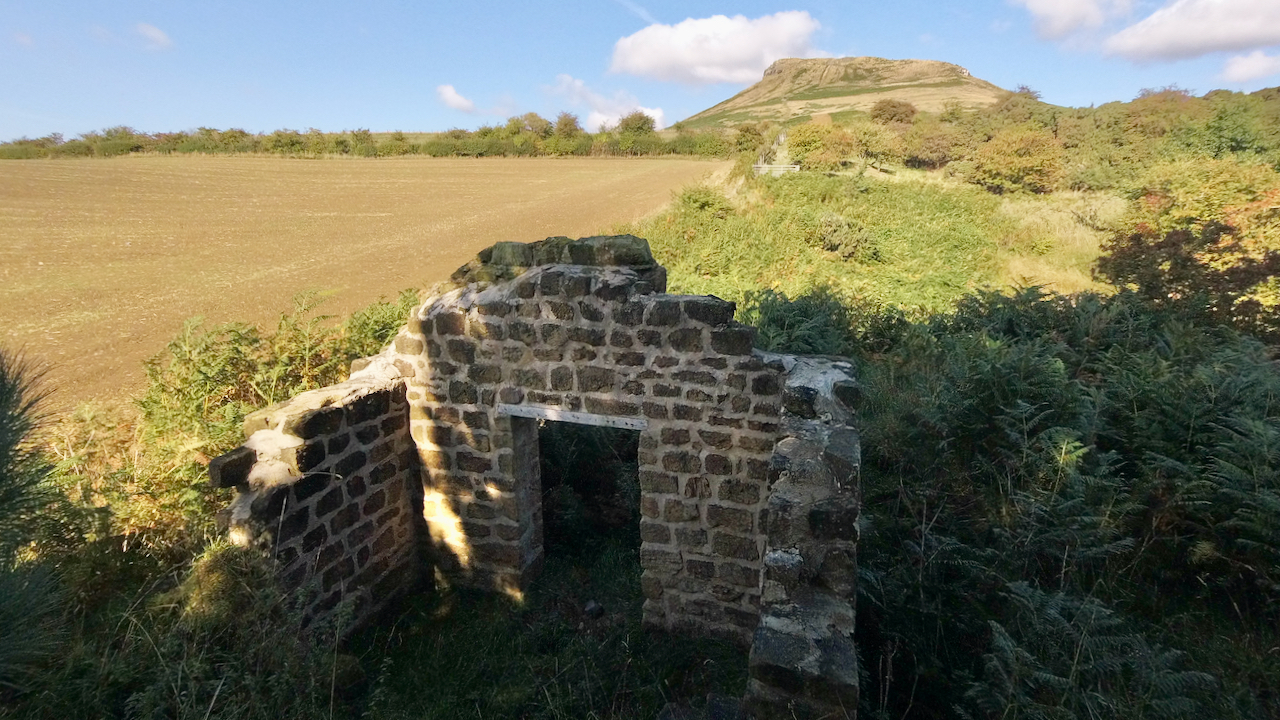Had a wander down to the old Powder House to see how it’s faring.
The pointing applied to conserve the gable wall facing Roseberry looks as though it’s doing its job. The rest of the stone walls, reduced to a few courses, are grassing over1North York Moors Historic Environment Record (HER) No: 1271. The tramway down is a jungle of bracken.
At this I must point out that the powder house is not on a Public Right of Way; I have been given permission to visit.
The powder house would have been approximately 6m by 4m wide, comprising a double skin of sandstone, with a slate roof and surrounded by an earth bund. All to limit the impact of an explosion. It is thought the walls were internally clad with wood to reduce the risk of sparks2Pepper, Richard. “Roseberry Ironstone Mine”. Page 20. Cleveland Ironstone Series. Published by Peter Tuffs 1999.. The powder would have been distributed in a vestibule adjacent to the door.
If Roseberry Mine was no different to other Cleveland ironstone mines, and there is no reason to suggest it was, the miners had to purchase the powder together with the ‘squibs‘ to ignite it. One of the tasks of the Powder Monkey was to keep the accounts so that the costs could be deducted from the miners’ wages at the end of the week3Brighton, W. E. “Ironstone Mining in Eston”. Cleveland Ironstone Series. page 9. Published by Peter Tuffs. 1996..
Sometimes the squib became damp and failed to ignite the powder, hence the expression ‘damp squib’.
The powder was carried in a specially made tin slung over the shoulder by a tarred rope. I recall being told that, rather than waste any unused powder at the end of the shift, the miner would take the tin home and keep it by his fire to keep dry.
The powder was generally referred to as ‘black powder‘, and comprised 10% sulphur, 75% saltpetre and 15% charcoal, compressed by the manufacturer into a cartridge shape 4Brighton, W. E. “Ironstone Mining in Eston”. Cleveland Ironstone Series. page 13. Published by Peter Tuffs. 1996.. It was categorised as ‘low explosive’ but certainly enough to do some damage if mishandled.
It must have been a lonely life being a powder monkey, No jocular banter with the miners or the tram drivers who would have been keen to put some distance between themselves and this bomb. But what a cracking view.
- 1North York Moors Historic Environment Record (HER) No: 1271
- 2Pepper, Richard. “Roseberry Ironstone Mine”. Page 20. Cleveland Ironstone Series. Published by Peter Tuffs 1999.
- 3Brighton, W. E. “Ironstone Mining in Eston”. Cleveland Ironstone Series. page 9. Published by Peter Tuffs. 1996.
- 4Brighton, W. E. “Ironstone Mining in Eston”. Cleveland Ironstone Series. page 13. Published by Peter Tuffs. 1996.

Leave a Reply